For the first time since the Arabic of Morocco, in Tanzania, I’ve had the advantage of some real immersion in a local language. In West Africa, the abstract colonial borders have combined with subsequent economic and political migration to weave a tapestry of local languages. I remember sitting outside a coffee shop in Guinea, chatting away with the locals in French, when a man pulled up on a motorcycle and hit me with a barrage of Susu. When I looked perplexed he asked, accusingly, why I didn’t speak the local language. Because I’ve only been in the country for 10 days, I replied, and there are 10 languages.
But in Tanzania – and, thankfully, in Kenya, Uganda, and even parts of Rwanda – people share a common tongue. For the next six weeks, Swahili will form a linguistic backdrop. So I’ve been making an effort to wrap my head around it. In Zanzibar, these efforts produced little more than a bunch of mambo jambo (both of these translating as a variation of how are you). But, luckily, the language is user friendly, and progression is swift. The pronunciation is mostly phonetic, and the words have a melodic quality that allow even the most basic phrases to take flight. Like German, compound nouns exist and, unlike French, the numbers aren’t an exercise in rapid mental arithmetic. Far from simply granting the convenience of communication – in instances where the local language is (rightly) the common denominator – learning a few vernacular phrases also opens the door to much richer interactions; ones where far less is said, but far more is understood. As you know, my fledgling phrases did little to win over the suspicious hotelier in Korogwe. But a few miles out of town, they were given their chance to shine.
Chai is by far the most popular brew in Tanzania. It’s made almost exclusively by women and often in combination with a fresh chapati or two. Coffee shops, by comparison, are far rarer, but they’re cut from the same cloth as their West African cousins. The punters – an exclusively male clientele – can seem a rather hostile bunch at first, but they soon warm up as you regale them with heroic stories from the road (as you can imagine, amping up the heroism lands well with the men). So was the case in Makuyuni. Our arrival at the roadside coffee shack was met by a smattering of grunts, nods, and mambos. For us outsiders, the owner quoted a lofty thousand shillings per cup. Luckily, I’d been in the country long enough to recognise this five-fold inflation. Instead, I was able to roll out a counter offer, mia mbili (two hundred), kindly requesting bei kaka (brother price) instead of the mzungu (white man) price we’d been greeted with. Our offer was duly accepted and the gathered group quickly thawed. Before long, we were taking turns doing pull-ups on a nearby tree branch, with the owner – who moonlighted as the village’s P.E teacher – performing an impressively clean 12 reps without breaking a sweat. It was clearly some strong kahawa (coffee).
While some of us were busy fooling around in the tree, Seamus was engaged in some under-the-table dealings. Not far out of Korogwe, we’d been joined by a local cyclist. He’d followed us up the winding mountain roads, occasionally speeding by in a blur of colour as a subtle reminder of just how sluggish our pace was. However, it wasn’t the cyclist’s bright Lycra that caught Seamus’ eye. Up until now, thanks to the failure of our mission in Dar Es Salaam, he’d been riding without a helmet. So, when fate delivered him a companion sporting such a precious commodity, Seamus spied an opportunity to strike a deal. We’ve since been merciless in our ribbing of this exchange which sent the local back down the perilous passes to Korogwe unprotected, while Seamus rode on in total safety. The phrase neo-colonial may have slipped out once or twice…
Our afternoon of riding was blissful, and not just because we’d finally secured the safety of our whole group – albeit at someone else’s expense. The climb out of Korogwe had taken us onto a plateau. Almost immediately, the landscape changed dramatically. The arcing ridgeline of the Usambara mountains, draped in the dense greenery of its virgin rainforest, framed our horizon. In the basin, the land around the road was divided into neat squares whose mirrored surfaces gave a clue about the crops submerged below. The road itself was arrow straight; a false flat which, thankfully, began to reveal itself as a deceptive descent. It was the sort of riding that makes you feel like you could pedal indefinitely. We cruised along, the wind and the subtle gradient easing us steadily north.
That night, we camped in a quarry. It was a little further from the road than we often pitch. And with this relative departure from civilisation – where civilisation was a small hamlet in the middle of 50 square kilometres of open plains – came a nugget of nagging worry. Wildlife. As you know by now, one member of our group is more anxious than the rest on this front. While I’d been locking in the numbers, Tom had been diligently committing some other Swahili to memory. Kuna simba hapa? (Are there lions here)? As the sun began to set, some Masai goatherds led their flock through our camp. The phrase may have slipped off Tom’s tongue with ease, but its answer brought with it a distinct sense of unease. It seemed there were lions here; many of them, in fact, prowling the forested escarpment just above our camp.
We survived the night, but while packing up our tents in the dim light of dawn, we heard strange sounds echoing through the trees above. Could it have been a lion? Tom was sure of it. He called a quick vote to determine if what we’d heard could be classed as a roar. Despite the outcome – which saw three quarters of us rather less convinced – he packed up camp with uncharacteristic efficiency and fled to the safety of the road. This hasty retreat set the pace for the morning.
Besides burnishing his prized Swahili phrase, Tom has been equally diligent in his study of German, spending a good chunk of his free time glued to Duolingo. In turn, we’ve been spending some of ours quizzing him on what he’s learnt. That morning’s delight – as a response to wie gehts? (how are you?) – was ich bin schnee. The German scholars among you will recognise this as a rather incongruous I am snow. But you’ll have to remember that it’s still early doors for Tom’s German. He’d meant to say ich bin schnell (I am fast) – which, that morning, he was. As a rather unwelcome shock for our heavy legs, for the first 20 kilometres, Tom led an assault on the day’s distance. Despite the fact that both the tailwind and the subtle gradient had vanished, we maintained the same pace as the previous day, charging along at 30 and change. By the time we stopped for our morning chapati and chai, we’d thoroughly emptied our tanks, and all agreed that the lion – had it existed – might have given up the chase by now.
Much like my veg curry ritual with Ellie in Zanzibar, we’ve settled into similarly predictable mealtime routines on the mainland. Chapatis and chai; beans, veg and rice; and chipsi mayai. It’s got quite a ring to it, now I think of it. Each mealtime also follows a familiar timeline. First, we determine what’s on offer, running through our set menu of possible dishes: pilau? (rice?); maharage? (beans?); mboga? (veg?) Then we work out the price – ngapi? (how much?) – being careful to avoid the significant Mzungu tax commonly tacked onto the bill of unassuming westerners. We quickly polish off our meals, enjoy a cut-through coke from a glass bottle – the result of Tanzania’s progressive anti-plastic policies – and set off. Finally, we circle back to retrieve whatever item Seamus has decided to leave behind that day. This day was no different, and ended with a u-turn to collect his newly acquired helmet. I’m sure you can imagine the mocking this omission triggered.
After spending the six days from Dar chugging along three predominantly straight highways, it was a relief to finally turn off the tarmac and be greeted by gravel. We’d made a decision to divert via Chemka hot springs – which, according to the signage, is home to the clearest, most cleansing waters on the planet. With credentials like that, who could refuse a dip? There was much discussion about which route we should take through the tangle of rough tracks that weave their way to Chemka. During my solo months, I’d been judge, jury and executioner when it came to route planning. I’d decided to deal with the recent influx of chefs by stepping well away from the route-related broth, preferring to act as a consultant in moments of crisis than pedalling my own directional manifesto. However, having suffered at the hands of Komoot’s haphazard algorithm once too often – you may remember my pedestrian traverse of the Rif Mountains of Morocco – I donned my apron once more and headed for the kitchen.
Tom was the resident chef that day, and had planned a Komoot route to the springs. I, on the other hand, had used my alternative mapping app, OsmAnd, to provide what I was sure was a far safer bet. And so began the contest. Whenever Tom’s route took us onto remotely rough terrain, I’d complain that it was impossible and take charge with my meandering alternative. And whenever my route looked like it was taking an unnecessary detour, Tom would jump in and trim the fat. On one occasion, we even split ways to follow our respective tracks: Tom’s a 500 metre hike-a-bike up a narrow scree slope, and mine, a two kilometre detour on a slowly climbing track. Predictably, we arrived more or less in tandem.
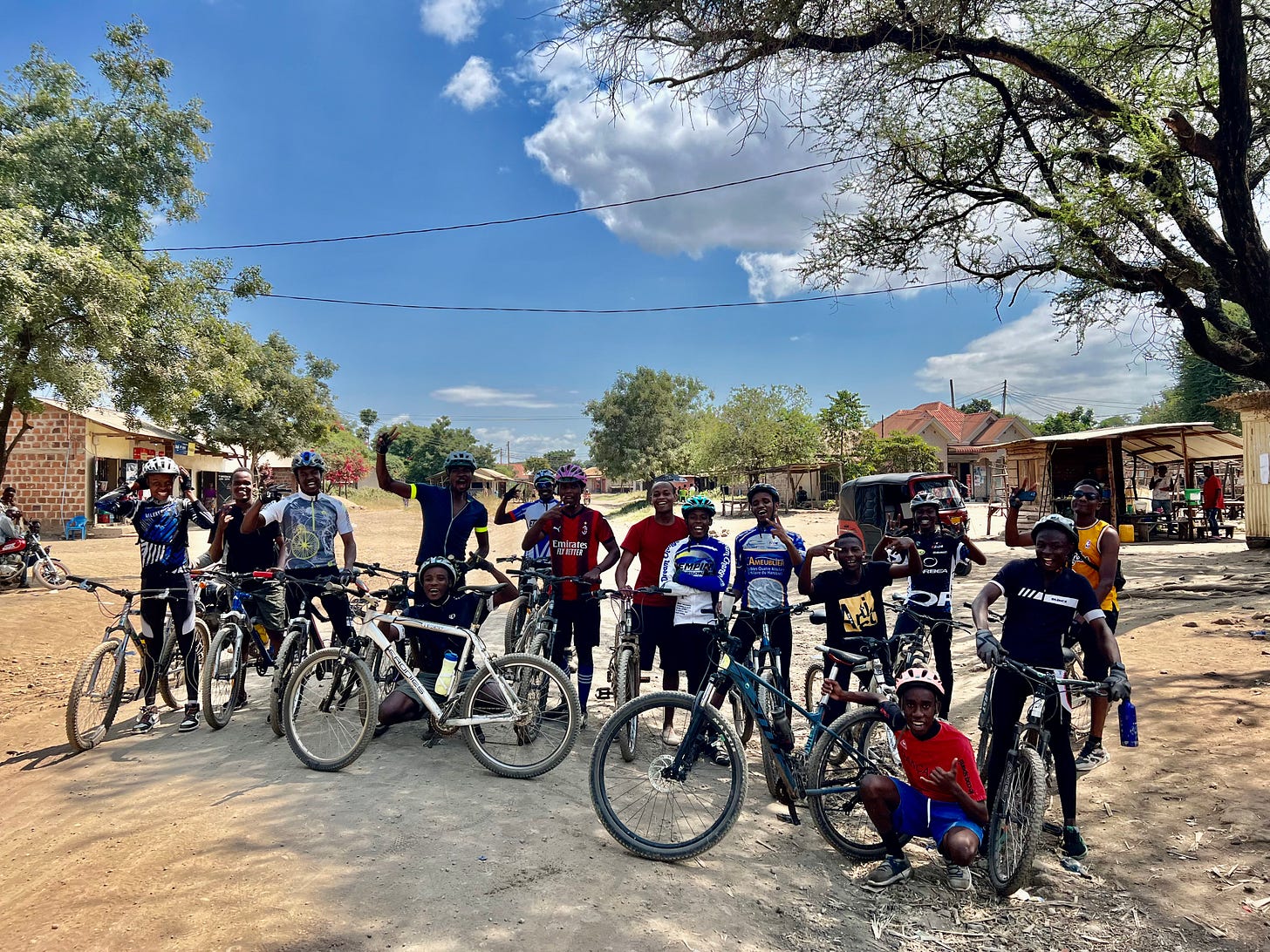
Eventually, through what turned out to be a strong combined effort, we arrived at Chemka. Here, we quickly discovered that the phrase bei kaka fell on deaf ears. This was the unmistakable territory of Mzungu prices. Our regular chipsi mayai had almost doubled in price, and the cost of our chapatis the following morning rose three-fold. Not only was the food expensive, we were also told that if we’d like to camp, we’d need to pay for a guard. Although you might think Tom would leap at the chance for some personal security to ward off the unwelcome wildlife, we all shared the same reluctance to cough up. But the powers that be were not for persuading and we resigned ourselves to the tourist tax.
This wasn’t the last we’d see of Mzungu pricing. After half a rest day in Boma Ng’ombe, we hit the road at the crack of dawn with grand plans to ride through the Arusha National Park – a wildlife reserve that bisects Mounts Kilimanjaro and Meru. Following yet another morning assault, we stopped for breakfast just before the park. Some preemptive googling revealed the extent of our naivety; while drawing up our route, we’d completely forgotten that entry to these national parks carries a hefty price tag. And the Mzungu price was an eye-watering 20 times of the bei kaka of the locals. Regardless, there was an energy among us to see some of the wildlife that so often characterises this part of the world. So, ignoring the financial disincentive, we made the decision to climb the steep seven kilometre pass to the park gate to scope out our options. On arrival, however, it quickly became clear that the costs didn’t stop at entry.
Besides the $60 to access the park – marketed primarily as a conservation fee – there was an additional $30 fee for cycling, which was classed as an additional activity. This seemed strange; if conservation was the goal, surely encouraging passage by bike was preferable to the diesel guzzling stretch-jeeps that typically ferry tourists through the reserve. But the bill didn’t stop there. It was necessary for one of these jeeps to accompany us through the park – for our safety, of course – which would cost was a further $20. Oh, and if we’d like that jeep to have a driver, that would be charged as extra. By this point, our motivation had begun to wilt, but given we’d already sunk the cost of the climb, we decided to probe further. This is when we discovered that there were no jeeps currently available, and that our best shot was to arrange one over the phone with a contact we’d been assured would give us the best price. After some back and forth, an email pinged into our inbox with a quote of $250 – ten times what we’d been told to expect. Decision made. With that, we turned on our heels – Mzungu tails between our legs – and descended back to the road, where a significant chunk of riding awaited.
By avoiding the park, we took a sizeable penalty on the day’s distance. And it wasn’t flat riding. We climbed relentlessly, ascending through biome after biome until the road finally flattened out onto an arid plateau. The mood had dampened as we’d trucked along; a collective exhale as the imagined excitement of Arusha faded. But the cobwebs were soon blown out on the descent. 20 kilometres of smooth, empty road fell from the shoulder of Mount Meru, injecting a sense of play once more into the day. We wove around one another, plaiting paths down the mountainside. We even began looking out for wildlife; after all, thanks to Tom’s search history, we know that there aren’t fences around the national parks. Who knows? It might have been the day that some of that precious wildlife wandered beyond the paywall.
But, after several imaginative attempts to superimpose stripes on sheep, we’d seen nothing more than you’d find in Wales; bar some reptilian roadkill. The closest we got to exotic was when Nadia pointed out an enormous caterpillar crossing the road ahead of us. Freewheeling at speed, Seamus barely had the chance to ask where? before the poor creature disappeared beneath his wheels. If there was one redeeming feature of the national park’s rejection, it was that we hadn’t had the chance to unleash Seamus on their wildlife. Who knows what endangered species might have met their end under those tyres?
In the end, Tom and I became so bored of this makeshift safari that we decided to make some fun of our own. While the other wasn’t looking, one of us would pedal stealthily behind them and surreptitiously unclip some item of their luggage before cycling past, feigning innocence. The same deft deception would then be reciprocated a little further down the road. It was our very own game of predator versus prey – far more action than we’d have witnessed in Arusha, no doubt. Before long, the game had escalated to a point where the mere presence of another cyclist in either of our peripheries would produce a panicked Pavlovian head swivel. At one point, after managing to pull off a clean strike on Tom’s tail bag, I sensed him closing in to retaliate. Further ahead, a local bus had just picked up a very incremental passenger and was slowly regaining speed. In a burning anaerobic burst, I pedalled to within an inch of its rear bumper, just managing to grasp the ladder attached to the back before it accelerated. Tom laid chase and came within spitting distance before the bus changed gear and pulled me out of his reach to safety. 1:0 to the prey.
A kilometre up the road I let go and cruised to a halt to reclip my open luggage. Tom soon joined me to reattach his own, both of us in blissful ignorance of what stood beside us. Having resecured our bikes, we pedalled blindly off. Luckily Nadia was paying closer attention. We heard a shout behind us and turned to see her in the distance, beckoning us frantically. As we moved closer, a word carried on the wind. Giraffe. While we’d been fooling around with each other’s bikes, one of these impossibly majestic creatures had been standing mere metres from us. The unlikely camouflage of its skin had hidden the towering obelisk of its frame entirely. It was a truly surreal sight. We all gathered and watched as it grazed on an acacia beside the road. With its meal finished, it turned towards us, fixing us with a placid gaze. Three of us were transfixed by its beauty. One of us was not. Oh shit, Tom said, primed for retreat, what are we saying about that.
The delight of the lone giraffe, glowing in the early evening light, was a reminder of one of the golden rules of cycle touring – something that sets it apart from the traditional bounds of tourism. Moments like these can’t be arranged or bought; they can’t be manufactured. In the end, the magical is given away freely, at the most unlikely moments, as a reward for enduring the mundane.





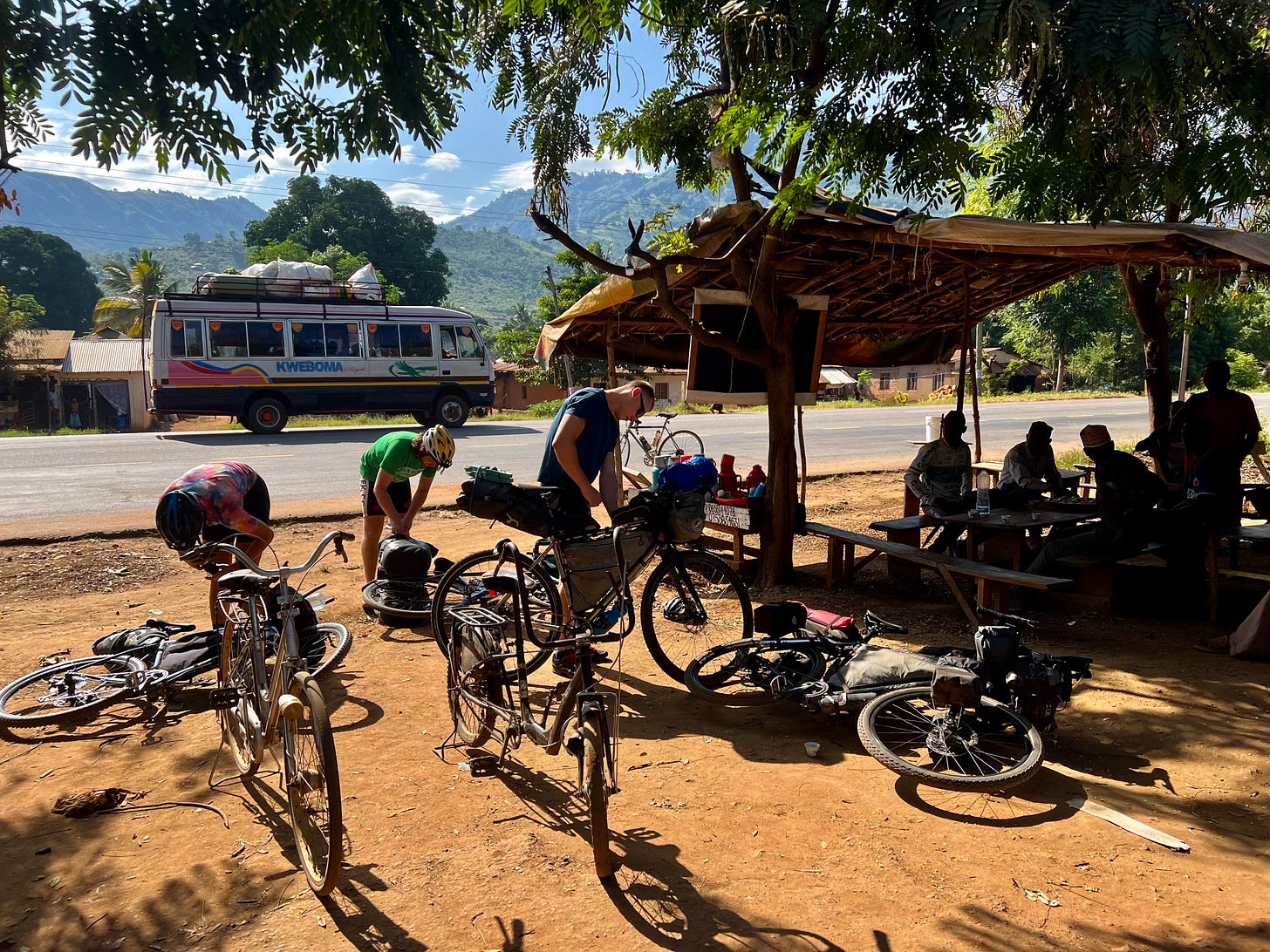
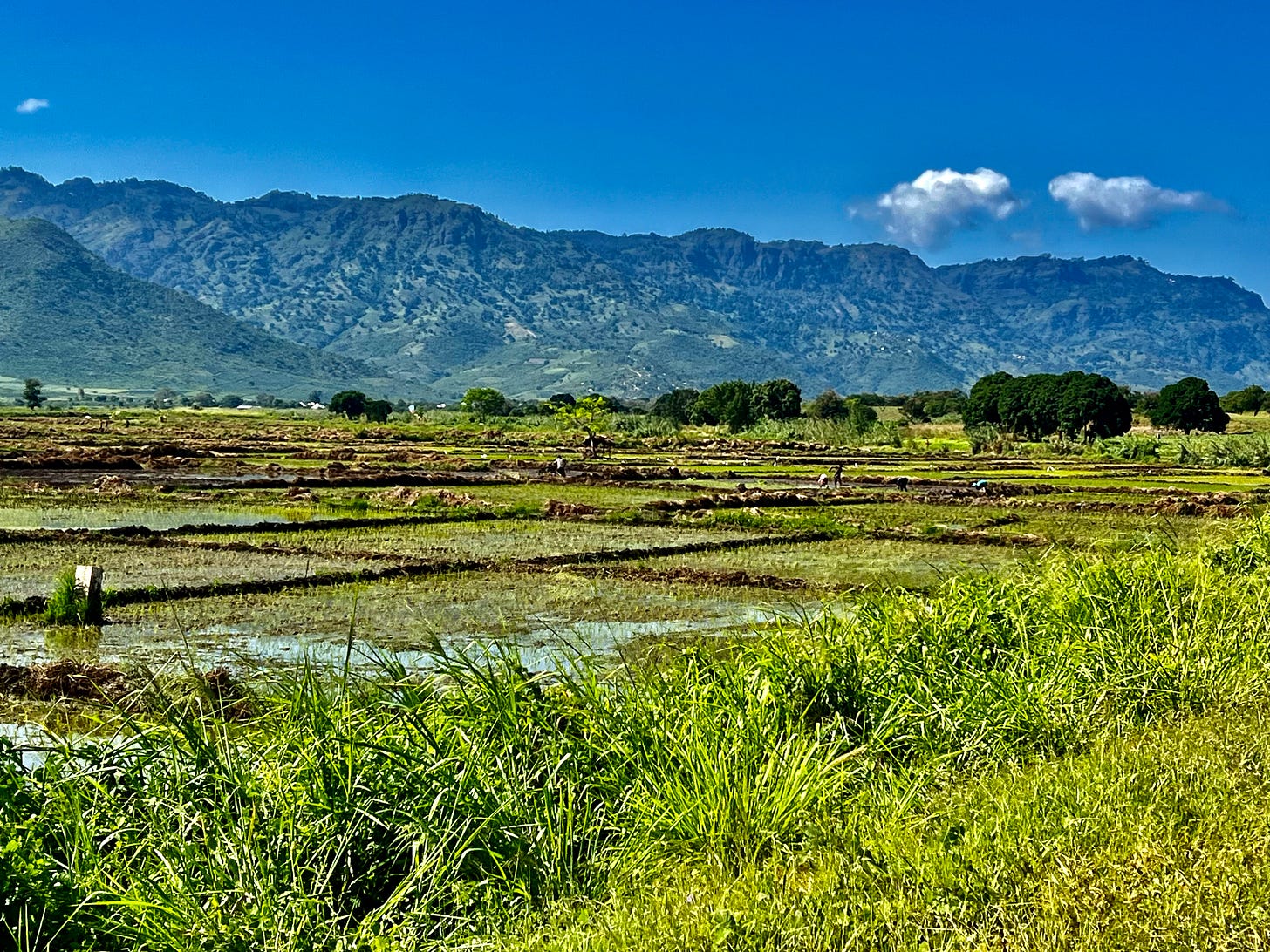
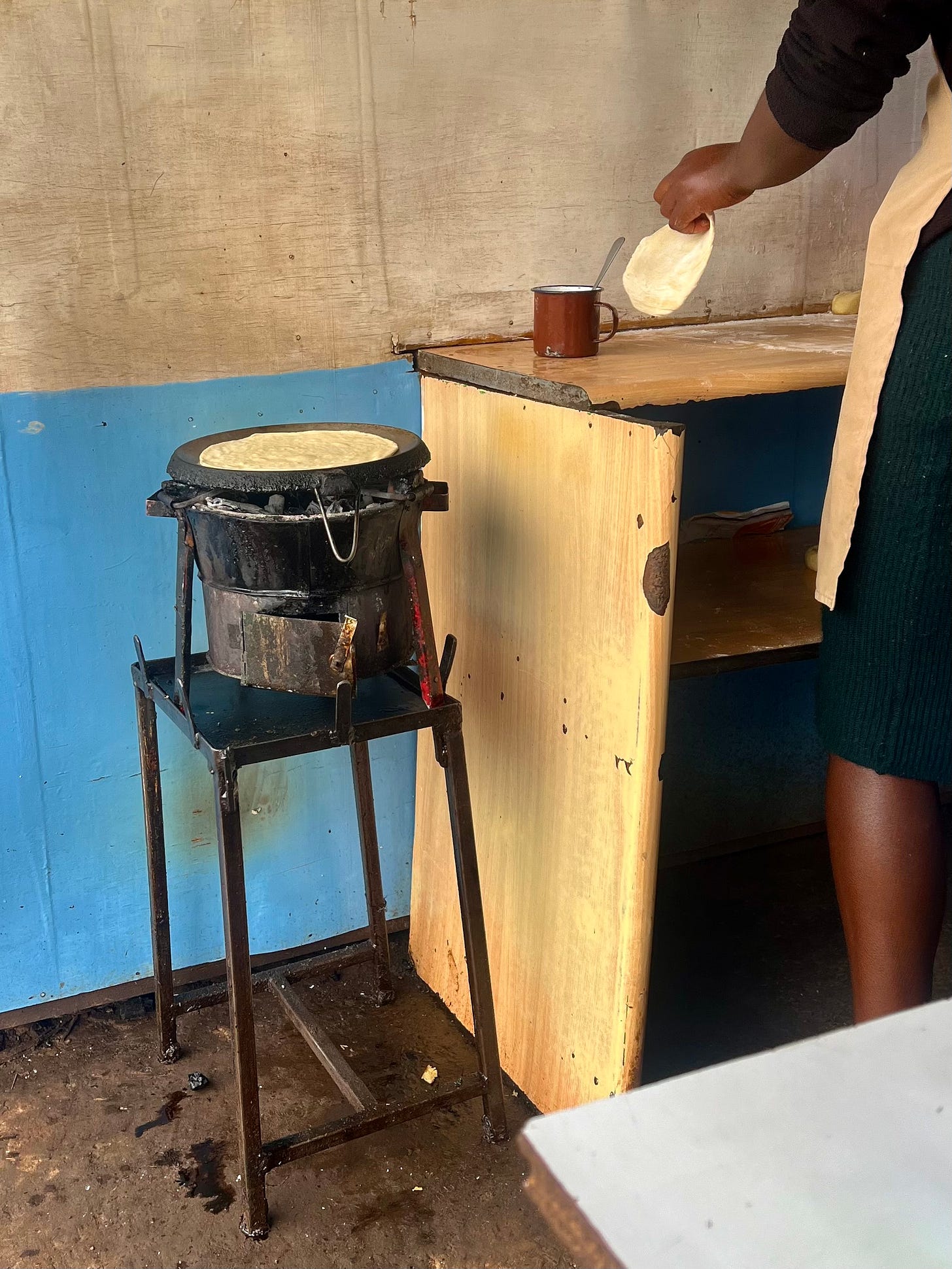
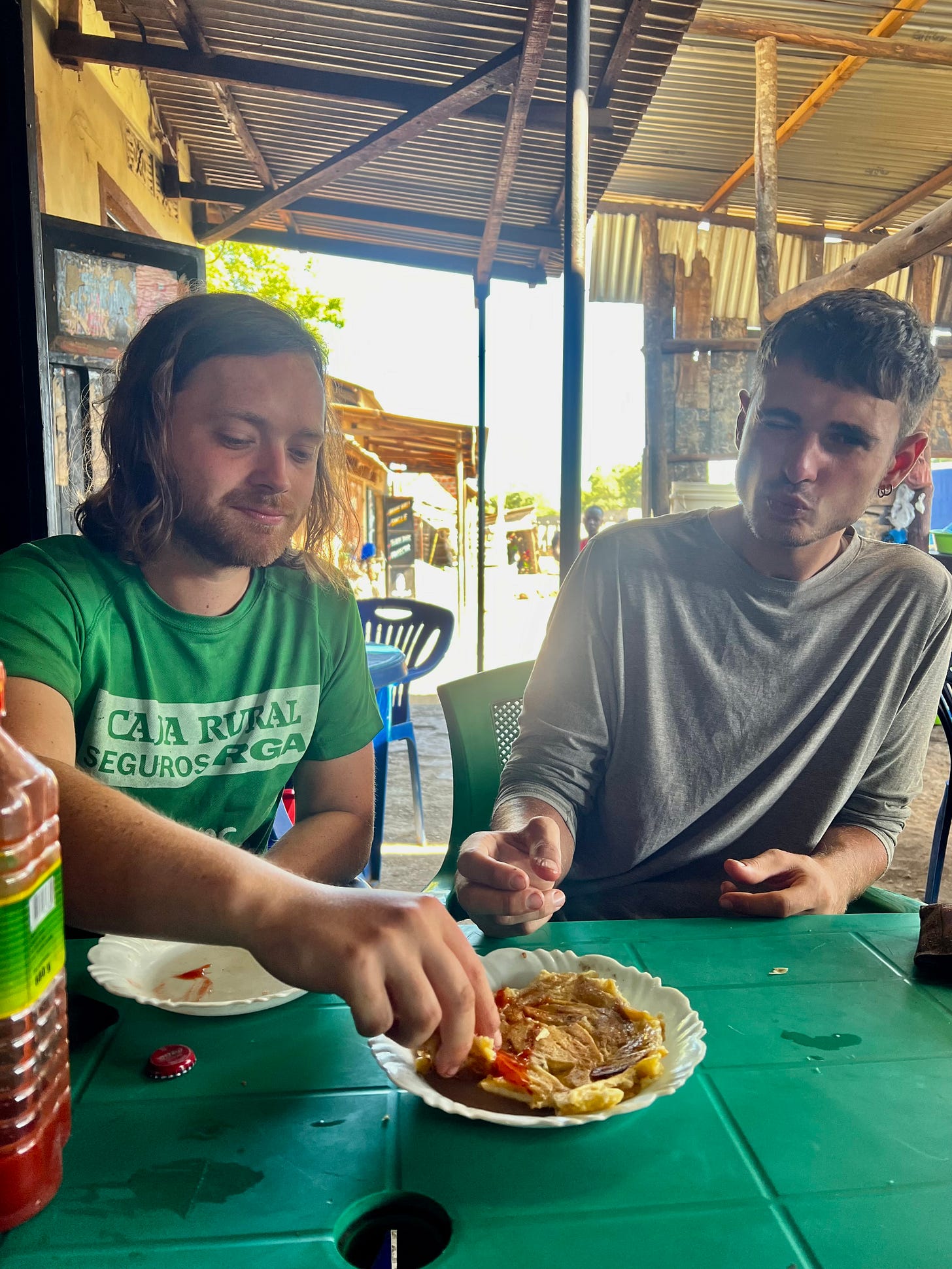
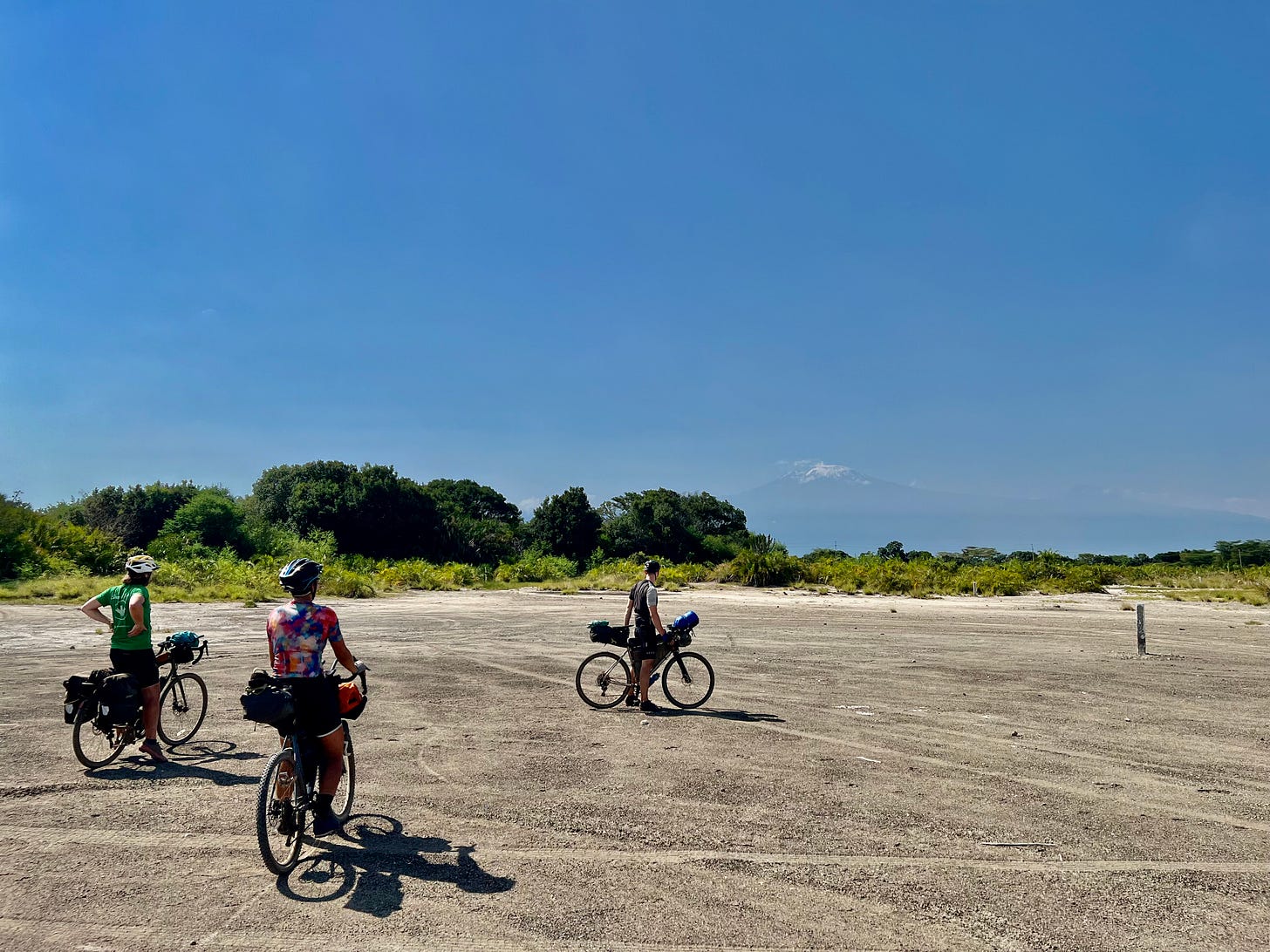
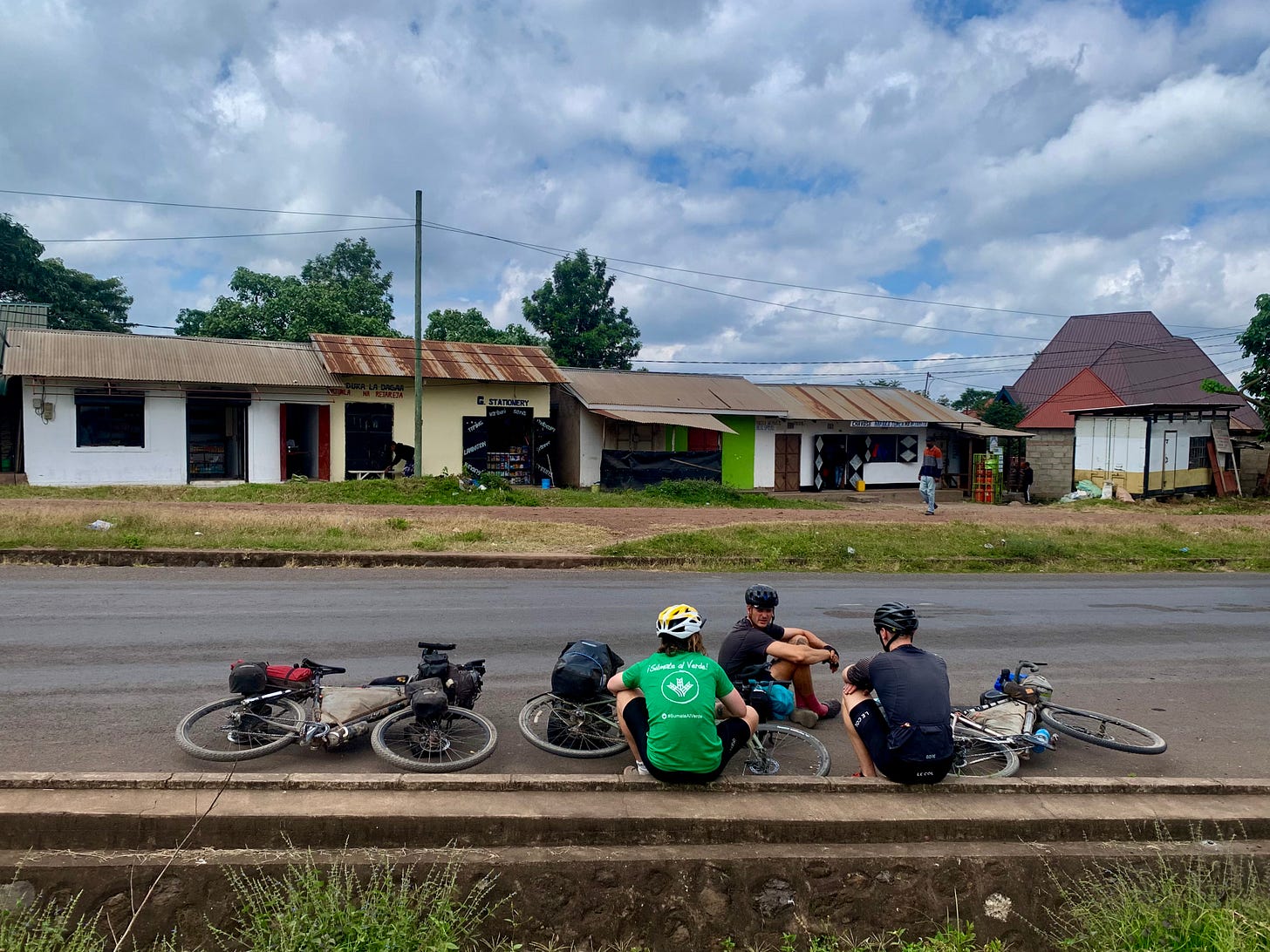


Close encounter with the mystical, magical giraffes 🦒 ✨️- wonderful
Enjoy the company and the mix of options that provides ...... more than one route can lead to your planned destination! XxxX
Will put me onto your blog. Loved reading this and what a beautiful conclusion! Will definitely be reading from now on :)